I can't quite figure this one out.
I am trying to approximate the location (latitude / longitude) of a beacon based on 3 distance measurements from 3 fixed locations. However the distance readings available may have an error of up to 1 km.
Similar questions regarding trilateration have been asked here (with precise measurements), here, here (distance measurement errors in Java, but not in lat/lon coordinates and no answers) as well as others. I also managed to dig up this paper dealing with imperfect measurement data, however it for one assumes a cartesian coordinate system and is also rather mathematical than close to a usable implementation.
So none of above links and answers are really applicable to the following problem:
- All available distance measurements are approximated in km (where data most frequently contains readings in-between 1 km and 100 km, in case this matters)
- Measurement errors of up to 1 km are possible.
- 3 distance measurements are performed based on 3 fixed (latitude / longitude known) positions.
- target approximation should also be a latitude / longitude combination.
So far I have adapted this Answer to C#, however I noticed that due to the measurement inaccuracies this algorithm does not work (as the algorithm assumes the 3 distance-circles to perfectly intersect with each other):
public static class Trilateration
{
public static GeoLocation Compute(DistanceReading point1, DistanceReading point2, DistanceReading point3)
{
// not my code :P
// assuming elevation = 0
const double earthR = 6371d;
//using authalic sphere
//if using an ellipsoid this step is slightly different
//Convert geodetic Lat/Long to ECEF xyz
// 1. Convert Lat/Long to radians
// 2d. Convert Lat/Long(radians) to ECEF
double xA = earthR * (Math.Cos(Radians(point1.GeoLocation.Latitude)) * Math.Cos(Radians(point1.GeoLocation.Longitude)));
double yA = earthR * (Math.Cos(Radians(point1.GeoLocation.Latitude)) * Math.Sin(Radians(point1.GeoLocation.Longitude)));
double zA = earthR * Math.Sin(Radians(point1.GeoLocation.Latitude));
double xB = earthR * (Math.Cos(Radians(point2.GeoLocation.Latitude)) * Math.Cos(Radians(point2.GeoLocation.Longitude)));
double yB = earthR * (Math.Cos(Radians(point2.GeoLocation.Latitude)) * Math.Sin(Radians(point2.GeoLocation.Longitude)));
double zB = earthR * (Math.Sin(Radians(point2.GeoLocation.Latitude)));
double xC = earthR * (Math.Cos(Radians(point3.GeoLocation.Latitude)) * Math.Cos(Radians(point3.GeoLocation.Longitude)));
double yC = earthR * (Math.Cos(Radians(point3.GeoLocation.Latitude)) * Math.Sin(Radians(point3.GeoLocation.Longitude)));
double zC = earthR * Math.Sin(Radians(point3.GeoLocation.Latitude));
// a 64 bit Vector3 implementation :)
Vector3_64 P1 = new(xA, yA, zA);
Vector3_64 P2 = new(xB, yB, zB);
Vector3_64 P3 = new(xC, yC, zC);
//from wikipedia
//transform to get circle 1 at origin
//ransform to get circle 2d on x axis
Vector3_64 ex = (P2 - P1).Normalize();
double i = Vector3_64.Dot(ex, P3 - P1);
Vector3_64 ey = (P3 - P1 - i * ex).Normalize();
Vector3_64 ez = Vector3_64.Cross(ex, ey);
double d = (P2 - P1).Length;
double j = Vector3_64.Dot(ey, P3 - P1);
//from wikipedia
//plug and chug using above values
double x = (Math.Pow(point1.DistanceKm, 2d) - Math.Pow(point2.DistanceKm, 2d) + Math.Pow(d, 2d)) / (2d * d);
double y = ((Math.Pow(point1.DistanceKm, 2d) - Math.Pow(point3.DistanceKm, 2d) + Math.Pow(i, 2d) + Math.Pow(j, 2d)) / (2d * j)) - ((i / j) * x);
// only one case shown here
double z = Math.Sqrt(Math.Pow(point1.DistanceKm, 2d) - Math.Pow(x, 2d) - Math.Pow(y, 2d));
//triPt is a vector with ECEF x,y,z of trilateration point
Vector3_64 triPt = P1 + x * ex + y * ey + z * ez;
//convert back to lat/long from ECEF
//convert to degrees
double lat = Degrees(Math.Asin(triPt.Z / earthR));
double lon = Degrees(Math.Atan2(triPt.Y, triPt.X));
return new GeoLocation(lat, lon);
}
[MethodImpl(MethodImplOptions.AggressiveInlining)]
private static double Radians(double degrees) =>
degrees * Math.Tau / 360d;
[MethodImpl(MethodImplOptions.AggressiveInlining)]
private static double Degrees(double radians) =>
radians * 360d / Math.Tau;
}
Above code most often than not does not work in my case, and instead only returns "Not a number" as it tries to take the square root of a negative number when calculating the final z value (due to measurement inaccuracies).
In my case measurements may return data like this (visualized with some random online tool):
where only 2 or even none of the distance circles intersect:
What I am looking for is the an algorithm returning the best possible approximation of the target location based on three distance measurements with a known maximum error of 1 km or further approaches I could take.
I have also thought of iterating over points on the circles to then determining the minimum average distance to all the points on the other circles but the 3-dimensional sphere geometry of the earth is giving me a headache. Also there's probably a way better and simpler approach to this which I just can't figure out right now.
As this is more of an algorithmic problem, rather than any language-specific thing, I appreciate any help in whatever programming language, pseudo code or natural language.

